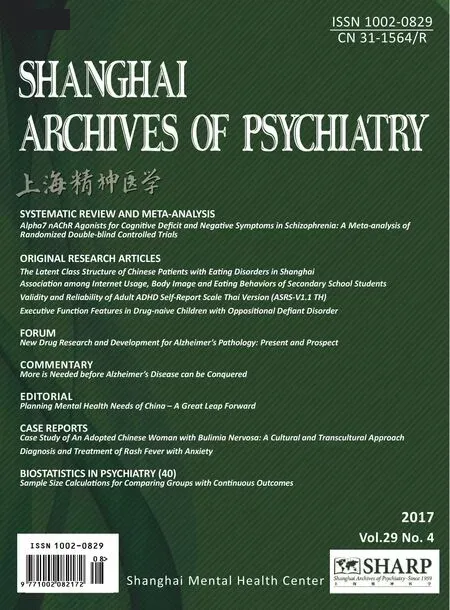New Drug Research and Development for Alzheimer’s Pathology:Present and Prospect
Tao WANG
•FORUM•
New Drug Research and Development for Alzheimer’s Pathology:Present and Prospect
Tao WANG
Dementia, β-amyloid, Tau protein, disease-modifying, treatment, clinical trial
As early as 1906, Dr. Aloysius Alzheimer found that erythropoiesis formed by β-amyloid (Aβ) deposition and the highly-phosphorylated Tau protein-induced neurofibrillary tangles were the brain pathological features of Alzheimer’s disease (AD). Since that time, almost all of the disease-modifying new drugs under development are targeting Aβ or Tau protein.In 2008, the author’s article “Treatment Progress Changes the Course of Alzheimer’s Disease” published in the Shanghai Archives of Psychiatry, highlighted that at that time numerous drugs based on the AD pathophysiological hypothesis were in phase II of clinical trials.[1]However, there has still been no fundamental breakthrough in the treatment of AD from these new drugs in trial.
Studies on the β-amyloid monoclonal antibody did not have any success in phase III trials.[2,3]On November 23, 2016, Eli Lily Company reported their new drug Solanezumab, an β-amyloid monoclonal antibody, had finished phase III of its clinical trial.Despite this medication achieving an 11% reduction in cognitive decline among patients with AD when compared to those in the placebo group, there was no significant difference in the ADAS-Cog scores (the primary measurement tool used in this study). Prior to this, studies of the β-amyloid monoclonal antibody Bapineuzumab[2](Pfizer Company and Johnson&Johnson Pharmaceuticals), and Gantenerumab[4](Roche Pharmaceutical) were already determined to have been unsuccessful or terminated during phase III of their trial. Perhaps the failure of Solanezumab is related to its single targeting of the soluble monomer β-amyloid and its inability to clear β-amyloid patches that have already gathered. Despite Gantenerumab as a fully humanized monoclonal antibody technically having the function of clearing β-amyloid plaques gathered in the brain of those with AD, however during its mid-term analysis of the phase III study no significant effect was shown,finally leading to announcement of study termination in 2014. An argument against β-amyloid antibody is that using β-amyloid antibody is too late in the course of AD, making it impossible to achieve a good outcome.The timing of medical interventions should be moved up to the prodromal period, mild cognitive impairment stage or earlier.[5]Another paradox is that the dosage of antibody in the brain is closely related to clinical effect but also the risk of adverse effect. By simply increasing the dosage, the absolute concentration does increase, but also activates the microglia cells in the brain and causes adverse effects. To address these questions, the Biogen Company recently reported that their new drug aducanumab could decrease the concentration of β-amyloid in patients with AD in a ti me and dose dependent manner (as shown in a phase I clinical trial).[6]Aducanumab is an antibody isolated from targeted senile plaques in the B-cells of healthy elders, it can increase the concentration of the drug in the brain without causing serious adverse reactions. At present, Biogen is conducting two Phase III clinical trials of Aducanumab, and the results are expected to be published in 2018. Roche and Genentech are designing their new antibodies Crenezumab based on the IgG4,which activates microglia cells less, and reduces the incidence of adverse reactions. Less adverse effects allow for a higher available dosage in clinical trials,opening up the possibility of achieving better results.
New drugs based on BACE1 (beta-site amyloid precursor protein-cleaving enzyme 1) and gammasecretase have also not shown success. In 2013, Eli Lily’s announced its gamma-secretase inhibitor Semagacestat had failed after phase III of the clinical trial. On 14 February 2017, Merck Company also terminated a phase III clinical trial of their BACE1 inhibitor Verubecestat,when it was considered extremely unlikely that it would obtain a clinically significant result. The reason for this failure is also related to the timing of intervention selected. By the time a diagnosis of mild AD is given it may be too late in the course of illness to successfully utilize an intervention which targets β-amyloid production.
Research into drugs targeting Tau protein is also facing difficulties.[7]Recently, the TauRx Company reported that the phase III trial of their new drug LMTM (an amethylthionine chloride derivation which was thought to be able to inhibit the generation of neurofibrillary tangles through Tau) was unsuccessful.In combination with standardized treatment, LMTM did not display any cognitive improvement for patients with AD. In recent years, a variety of products based on Tau protein have been developed and entered into phase I clinical trials: vaccines, antibodies and small molecule drugs. ACI-15 of Janssen and AC Immune are phosphorylation vaccines for Tau protein,which are currently enrolled in phase I clinical trials.Another drug is AXON’s AAD-vac1, which this year officially launched phase II clinical trials. AADvac-1 is an immune stimulator, it treats AD by simulating the body’s natural production of antibodies targeting pathological Tau protein. The advantage of vaccinebased interventions is the preventive function against the generation of neurofibrillary tangles, which often occurs long before a diagnosis of AD is given. Another intervention is antibodies that counteract the formation of Tau protein. In 2014, BMS-986168 (BMC Company)began phase I of a clinical trial. This antibody targets the N-terminal fragment of extracellular Tau protein.Also, the antibody RO7105705 producted by Genes Tektronix and AC Immuneis during this period entered a phase I trial as well. O-GlcNAcase inhibitor MK-8719 developed by Merck and Alectos recently completed a phase I trial. Its pharmacological effect is based on small molecular technology and indirectly inhibits the over-phosphorylation of the Tau protein by inhibiting excision of O-GlcNAc from Tau protein. Small molecule inhibitors targeting GSK3 (glycogen synthase kinase 3) were completely terminated because of the failure of a phase II trial of the GSK3 inhibitor by Noscira Company. When highly phosphorylated Tau protein is produced, the course of AD seems unstoppable.An effective intervention at this crucial period of the illness is needed. Lutein amide tablets are a new drug being developing in China, by the Chinese Academy of Medical Sciences Institute of Drug Research, with complete independent intellectual property rights.It’s pharmacological effect is based on the multiple pathways of AD pathology. Lutein amide inhibits neuronal apoptosis, β-amyloid deposition and Tau hyperphosphorylation. It was approved for phase II clinical trial in 2016. Fenkeronone is a pyrrolidone compound developed by Kunming Institute of Botany,Chinese Academy of Sciences and Kunming Institute of Animals, and is currently undergoing an exploratory phase II clinical trial. Amber octahydroacridine is a reversible dual cholinesterase inhibitor, which showed good results in both primary efficacy indicators ADASCog and secondary efficacy indicators ADL and CIBICPlus during phase II trials.[8]Phase III trials will begin this year. Mannose oligosaccharide dicarboxylic acid is an oligosaccharide extract obtained from seaweed, and was developed by China Oceanic University and the CAS Shanghai Institute of Materia Medica. In an experiment it was shown to inhibit neurotoxicity for β-amyloid. Its phase III trial using a 900mg daily dose is ongoing, with results to be released in 2018.
In conclusion, the results of clinical trials of these drugs have made us more aware of the complexity of the pathogenesis of Alzheimer’s disease. Although the hypothesis of amyloid and Tau protein is currently the mainstream explanation for AD onset,[9]it is possible that this is only the tip of the iceberg when it comes to the pathogenesis of AD. A series of novel approaches and innovations are currently emerging such as neurotransmitter based treatments, new drug delivery systems/ methods, cholesterol and lipid treatments,neurotrophic factor treatments, metal-protein chelation therapies, insulin/metabolic treatments, stem cells treatment, gene therapies, neuro-transplantation and neurosurgery treatments. Today, research on the genetic regulation of BACE1 mRNA is underway,[10]hoping to find a new target for AD intervention. We also expect to soon see new drugs which are based outside of the amyloid and Tau hypothesis.
Funding statement
Supported by the National Major Scientific and Technological Special Project grant for “Significant New Drug Development” (2015ZX09101003,2016ZX09101035), the National Natural Science Foundation of China (81571298, 81201030),Shanghai Science and Technology Committee grant(14411965000), Shanghai Jiao Tong University technological innovation special fund (YG2014MS39),SHSMU-ION Research Center for Brain Disorders, and the Fly Program of Shanghai Mental Health Center.
Conflict of interest statement
The author declares no conflict of interest related to this manuscript.
1. Wang T, Xiao SF. [Progress in delaying the development of Alzheimer’s disease]. Shanghai Arch Psychiatry. 2008;20(3): 186-188. doi: http://dx.chinadoi.cn/10.3969/j.issn.1002-0829.2008.03.019
2. Salloway S, Sperling R, Fox NC, Blennow K, Klunk W, Raskind M, et al. Two phase 3 trials of bapineuzumab in mild-tomoderate Alzheimer’s disease. N Engl J Med. 2014; 370(4):322-333. doi: http://dx.doi.org/10.1056/NEJMoa1304839
3. Doody RS, Thomas RG, Farlow M, Iwatsubo T, Vellas B, Joffe S, et al. Phase 3 trials of solanezumab for mild-to-moderate Alzheimer’s disease. N Engl J Med. 2014; 370(4): 311-321.doi: https://doi.org/10.1056/NEJMoa1312889
4. Panza F, Solfrizzi V, Imbimbo BP, Giannini M, Santamato A,Seripa D, et al. Efficacy and safety studies of gantenerumab in patients with Alzheimer’s disease. Expert Rev Neurother.2014; 14(9): 973-986. doi: https://doi.org/10.1586/1473717 5.2014.945522
5. The Lancet Neurology. Solanezumab: too late in mild Alzheimer’s disease? Lancet Neurol. 2017; 16(2): 97. doi:https://doi.org/10.1016/S1474-4422(16)30395-7
6. Sevigny J, Chiao P, Bussière T, Weinreb PH, Williams L, Maier M, et al. The antibody aducanumab reduces Aβ plaques in Alzheimer’s disease. Nature. 2016; 537(7618): 50-56. doi:https://doi.org/10.1038/nature19323
7. Asher Mullard. Pharma pumps up anti-tau Alzheimer pipeline despite first Phase III failure. Nat Rev Drug Discov.2016; 15(9): 591-592. doi: https://doi.org/10.1038/nrd.2016.176
8. Xiao SF, Wang T, Ma XQ, Qin Y, Li X, Zhao Z, et al. Efficacy and safety of a novel acetylcholinesterase inhibitor octohydroaminoacridine in mild-to-moderate Alzheimer’s disease: a Phase II multicenter randomised controlled trial.Age and Ageing. 2017; 17: 1-7. doi: https://doi.org/10.1093/ageing/afx045
9. Abbott A, Dolgin E. Failed Alzheimer’s trial does not kill leading theory of disease. Nature. 2016; 540(7631): 15-16.doi: https://doi.org/10.1038/nature.2016.21045
10. Wang T, Chen K, Li H, Dong S, Su N, Liu Y, et al. The feasibility of utilizing plasma MiRNA107 and BACE1 messenger RNA gene expression for clinical diagnosis of amnestic mild cognitive impairment. J Clin Psychiatry. 2015; 76(2): 135-141. doi: https://doi.org/10.4088/JCP.13m08812
基于阿尔茨海默病病理假说的新药研发现状及展望
王涛
概述:β-淀粉样蛋白(amyloid- β,Aβ)沉积形成的老年斑和高度磷酸化Tau蛋白导致的神经原纤维缠结是阿尔茨海默(Alzheimer's disease,AD)的病理特征,目前胆碱酯酶抑制剂和NMDA受体拮抗剂是治疗AD的主流药物,都定向作用于Aβ或者Tau蛋白。过去20年,许多基于阿尔茨海默病病理假说的新药都处于临床试验阶段。那些Aβ单克隆抗体和γ分泌酶抑制剂等新药定向作用于Aβ的病理通路。那些可抑制神经原纤维缠结和生成抗Tau蛋白抗体的新药则定向作用于Tau蛋白的病理通路。但至今尚没有根本性突破性的好消息。中国目前的研究似乎让人看到一丝曙光,一些具有完全自主知识产权的治疗AD新药正处在II期或III期临床试验中。
抑郁障碍,细胞因子,神经免疫
Summary: Cholinesterase inhibitors and N-methyl-D-aspartic receptor antagonists are currently the main treatments for Alzheimer’s disease (AD), targeting the clinical symptoms of AD. β-amyloid (Aβ) deposition and the highly-phosphorylated Tau protein-induced neurofibrillary tangles are some of the common pathological features of AD. In the past 20 years, many new drugs that focus on the pathogenesis of Alzheimer’s disease have been assessed in clinical trials. Drugs such as β-amyloid monoclonal antibody and gamma-secretase inhibitor target the Aβ pathological pathway. New drugs targeting the Tau pathological pathway inhibit the generation of neurofibrillary tangles and the Tau protein antibodies. But until now, none of these drugs has brought a fundamental breakthrough. This initial breakthrough may come out of China as there are several groups here which already have disease-modifying drugs in phase II and phase III of clinical trials.
[Shanghai Arch Psychiatry. 2017; 29(4): 237-239.
http://dx.doi.org/10.11919/j.issn.1002-0829.217045]
Shanghai Mental Health Center, Shanghai Jiao Tong University, Shanghai, China
correspondence: Tao Wang. Mailing address: Shanghai Mental Health Center, Shanghai Jiao Tong University, 600 South Wan Ping Road, Shanghai, China.Postcode: 200030. E-mail: wtshhwy@163.com

Dr. Tao Wang graduated from the Shanghai Jiaotong University School of Medicine with a doctoral degree in psychogeriatrics in 2012.He completed training as a visiting scholar in UNC IDEA Group,Biomedical Research Imaging Center, UNC Chapel Hill, NC, USA from 2015-2016, and Banner Alzheimer’s Institute, Arizona, USA from June in 2013 to July in 2013. Since 2013 he has been an associate chief psychiatrist in the department of geriatric psychiatry, Shanghai Mental Health Center,Shanghai Jiao Tong University School of Medicine. Now he is the vice director of the department of geriatric psychiatry at the Shanghai Mental Health Center. His main research interest is neurocognitive disorder.
- 上海精神医学的其它文章
- Sample Size Calculations for Comparing Groups with Continuous Outcomes
- Diagnosis and Treatment of Rash Fever with Anxiety
- Case Study of An Adopted Chinese Woman with Bulimia Nervosa: A Cultural and Transcultural Approach
- Planning Mental Health Needs of China – A Great Leap Forward
- More is Needed before Alzheimer’s Disease can be Conquered
- Executive Function Features in Drug-naive Children with Oppositional Defiant Disorder

